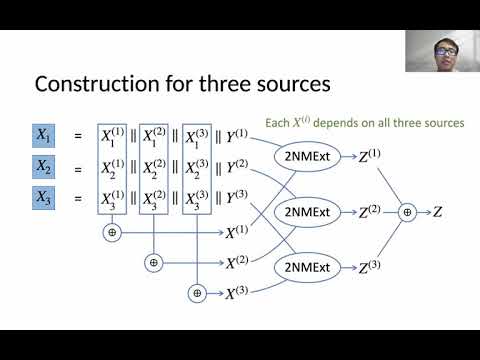CryptoDB
Multi-Source Non-Malleable Extractors and Applications
| Authors: |
|
|---|---|
| Download: |
|
| Conference: | EUROCRYPT 2021 |
| Abstract: | We introduce a natural generalization of two-source non-malleable extractors (Cheragachi and Guruswami, TCC 2014) called as \textit{multi-source non-malleable extractors}. Multi-source non-malleable extractors are special independent source extractors which satisfy an additional non-malleability property. This property requires that the output of the extractor remains close to uniform even conditioned on its output generated by tampering {\it several sources together}. We formally define this primitive, give a construction that is secure against a wide class of tampering functions, and provide applications. More specifically, we obtain the following results: \begin{itemize} \item For any $s \geq 2$, we give an explicit construction of a $s$-source non-malleable extractor for min-entropy $\Omega(n)$ and error $2^{-n^{\Omega(1)}}$ in the {\it overlapping joint tampering model}. This means that each tampered source could depend on any strict subset of all the sources and the sets corresponding to each tampered source could be overlapping in a way that we define. Prior to our work, there were no known explicit constructions that were secure even against disjoint tampering (where the sets are required to be disjoint without any overlap). \item We adapt the techniques used in the above construction to give a $t$-out-of-$n$ non-malleable secret sharing scheme (Goyal and Kumar, STOC 2018) for any $t \leq n$ in the \emph{disjoint tampering model}. This is the first general construction of a threshold non-malleable secret sharing (NMSS) scheme in the disjoint tampering model. All prior constructions had a restriction that the size of the tampered subsets could not be equal. \item We further adapt the techniques used in the above construction to give a $t$-out-of-$n$ non-malleable secret sharing scheme (Goyal and Kumar, STOC 2018) for any $t \leq n$ in the \emph{overlapping joint tampering model}. This is the first construction of a threshold NMSS in the overlapping joint tampering model. \item We show that a stronger notion of $s$-source non-malleable extractor that is multi-tamperable against disjoint tampering functions gives a single round network extractor protocol (Kalai et al., FOCS 2008) with attractive features. Plugging in with a new construction of multi-tamperable, 2-source non-malleable extractors provided in our work, we get a network extractor protocol for min-entropy $\Omega(n)$ that tolerates an {\it optimum} number ($t = p-2$) of faulty processors and extracts random bits for {\it every} honest processor. The prior network extractor protocols could only tolerate $t = \Omega(p)$ faulty processors and failed to extract uniform random bits for a fraction of the honest processors. \end{itemize} |
Video from EUROCRYPT 2021
BibTeX
@inproceedings{eurocrypt-2021-30852,
title={Multi-Source Non-Malleable Extractors and Applications},
publisher={Springer-Verlag},
doi={10.1007/978-3-030-77886-6_16},
author={Vipul Goyal and Akshayaram Srinivasan and Chenzhi Zhu},
year=2021
}

